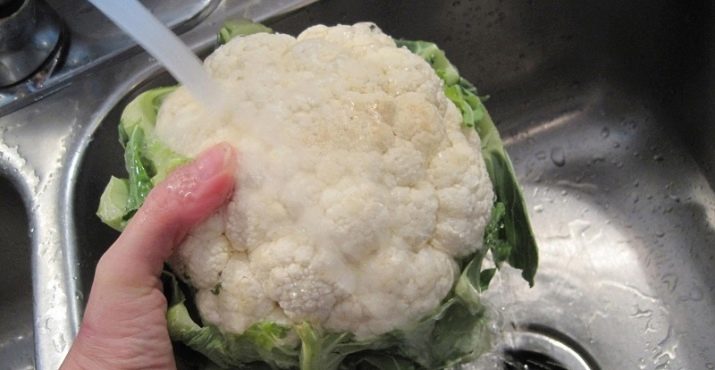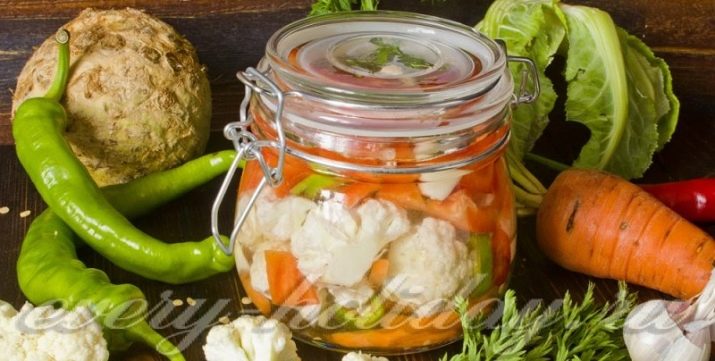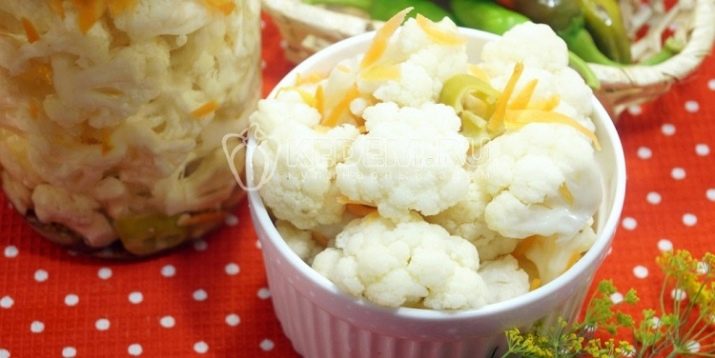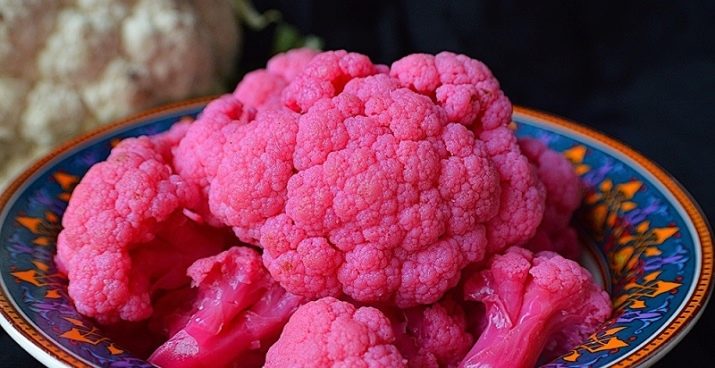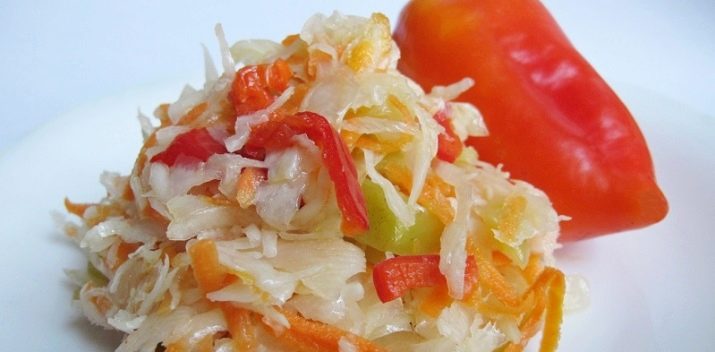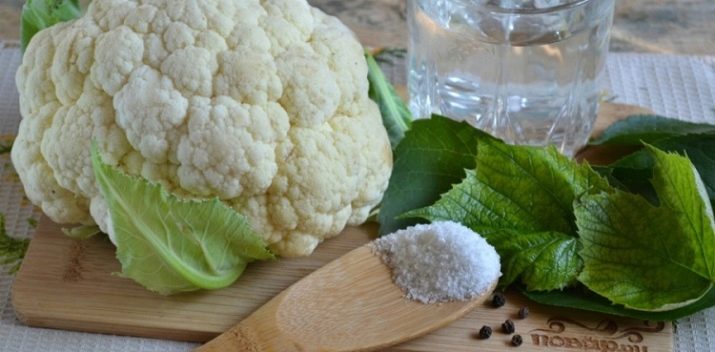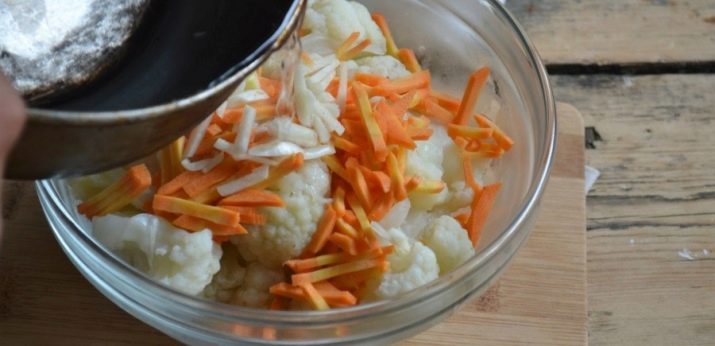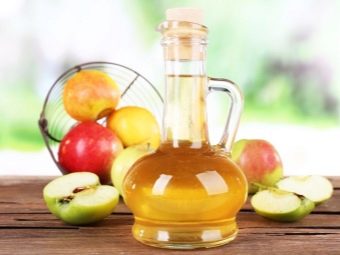Marinated Cauliflower: Calories and Instant Cooking Recipes for Winter
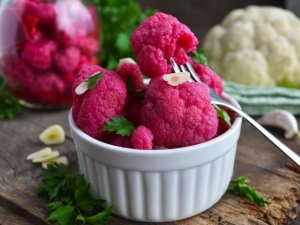
Among a large number of different types of cabbage culinary aesthetes are considered to be the color most sophisticated in taste.It is used for uncomplicated dishes, and for unusual raznozolov. It can act not only as a separate snack, but also as one of the ingredients. And it is harvested for the winter.
Dish properties
Cauliflower - the most useful among all varieties of cabbage. Its main property is easy digestibility. With the energy ratio of proteins - 33%, fat - 9%, carbohydrates - 56% its caloric value (energy value) is one of the lowest and amounts to only 30 kcal per 100 g:
- proteins 2.5 g (about 10 kcal);
- fat 0.3 g (about 3 kcal);
- carbohydrate 4.2 g (about 17 kcal).
Cauliflower is a source of vitamins (B, C, A, E, D, K, H and U), it is rich in carbohydrates, fiber, organic and polyunsaturated acids, starch, sugar, and includes enough mineral salts. Even with heat treatment retains most of its useful qualities.
Marinating is one of the most popular ways to cook cauliflower. Cooked in this way, cabbage will decorate any feast, delighting with its healthy taste and appearance.
Choice and preparation of vegetables
When choosing heads for blanks, it is advisable to choose healthy, clean, not overripe forks. A healthy vegetable has a uniform white or yellowish shade without any stains; varieties of cabbage with inflorescences of bright green color are very rare. The elasticity of the inflorescences and their close fit to each other is a sign of a healthy vegetable. Pay attention to weight: it must be harmonious in size.
The lightness of the head - an indicator of accelerated growth rates using chemicals: the benefits and juiciness in such a cabbage will be minimal. The presence of leaves between inflorescences suggests that such a vegetable will be very juicy, as the leaves protect it from drying out.
You should not eat cobs with loosely adjacent inflorescences, sluggish, with flabby leaves, with darkened spots, wetted areas, with a pungent, unpleasant smell, with the presence of insects.
Before cooking cabbage forks, you must wash (preferably under running water), sort out the inflorescences, separating each separately, cut off the roots. It is possible to prepare corollas in several large-sized inflorescences, dividing them before direct use into smaller ones.
What is combined?
Cauliflower goes well with any kind of meat and fish, it is unique in its use with other vegetables. With the addition of cream can make a more refined mash with potatoes, pumpkin, broccoli. Amazingly combined with stewing with potatoes, carrots, peas, green beans, zucchini, broccoli. Like other varieties of cabbage, good with fried onions and eggs. She is included in vegetable stews.
However, delicate cauliflower should not be combined with vegetables that have sharp taste characteristics, since they will destroy the refinement of its taste.
Carrot and beet are considered to be a great addition to it. Used in pickling, they saturate it with color and give a special flavor.
How to cook?
To marinate this tasty and healthy vegetable is a snap. We divide one cabbage forks into inflorescences, boil them for 2 minutes in water (1 l). Put in jars, first filling in half, add to the same place:
- chopped carrots (1 pc.);
- chili pepper - 1⁄4 pod;
- garlic - 4 cloves;
- black pepper - 4 peas.
After to the neck of the tank we lay the rest of the cabbage inflorescences. We put in the liquid used for blanching:
- 30 grams of salt;
- 4 tablespoons of vinegar;
- 50 grams of sugar.
Boiling marinade fill the contents of the cans. Then we close them in any way: we roll up or use twisted or usual plastic covers. Cabbage, cooked in this way, persists for a long time.
For those who want to try the dish as soon as possible, a quick marinating method is suitable.
We put in the dishes:
- 1 kg of cabbage inflorescences;
- 2 shabby carrots;
- garlic - 6 cloves;
- black pepper and fragrant - 4 peas;
- 1 leaf of laurel
In 1 liter of water add:
- vegetable oil - 4 tbsp. spoons;
- 40 g of salt;
- 90 g of sugar;
- vinegar - 100 ml.
Boil and hot marinade fill the contents of the cans and place in the cool. You can try it in a day.
Cabbage is easy to "decorate", giving it an unusual pinkish hue. Beetroot will help in this. Cut into small slices 1 beetroot. We put chopped garlic cloves, dill seeds, bay leaves, cabbage inflorescences interspersed with beet slices in jars.
Fill with boiling water and let stand for 20-25 minutes. Then we decant this water into the pot, add:
- sugar - 2 tbsp. l .;
- salt - 2 tbsp. l .;
- vinegar - 3 tsp. (based on 1 liter of water).
Hot marinade to the very neck fill the jars, then roll up. It is advisable to cover the banks with something warm (blanket), providing the possibility of slow cooling. Cooled banks are freed from heat insulation and set to cool.
Admirers of pickles will have more Korean-style cauliflower.
1 kg of cabbage requires:
- carrots - 1 pc .;
- garlic - 3 slices;
- salt - 1 tbsp. l .;
- sugar - 5 tbsp. l (with riding);
- coriander and ground black pepper - 1 tsp each;
- water - 0.7 l;
- vegetable oil - 40 ml;
- Table vinegar - 50 ml.
Dismantled on the inflorescences of cabbage forks blanch 5 minutes. Then take the cabbage out of the water and cool it. Mix cabbage with carrots, grated on a special "Korean" grater.
Boil the water with salt, oil and vinegar. Add spices (coriander, pepper). Pour the marinade with vegetables, add chopped garlic. We place at least 6 hours in the cool. Try it, it is very tasty!
Those who wish to prepare cabbage in Korean for the winter are offered another way. Based on 1 head, we take:
- 1 carrot and red bell pepper;
- 4 cloves of garlic;
- special seasoning in Korean.
Cabbage inflorescences boil no more than 2 minutes. We get them, combine them with carrots, worn on a special "Korean" grater, with pepper, chopped straw, and chopped garlic. Mix the mixture with plenty of seasoning and tamp as tightly as possible in jars. In 350 ml of water add:
- salt - 1 tbsp. l .;
- sugar - 2 tbsp. l .;
- table vinegar - 50 ml;
- vegetable oil - 50 ml.
Give boil. Fill jars with hot marinade right up to the neck, cover with metal lids and send for sterilization (15 minutes). Roll up.
For those who do not like to do sterilization, or who do not know how to do it, there is a way to prepare seals and easier. 1 cabbage fork divided into inflorescences. The bottom of the cans is covered with leaves of grapes (about 3 leaves, depending on their size), we put there 3-4 peas of black pepper, well tamping cabbage inflorescences.
Cooking marinade:
- we take 500 ml of water;
- 2 tablespoons (with top) salt;
- 2 tablespoons of sugar, boil;
- add 25 ml of vinegar and boil for some time.
Boiling marinade fill the contents of the cans. We warmly wrap a blanket, blanket, providing an opportunity to self-sterilize and gradually cool.
Those who are not particularly fond of spices, but prefer the dishes to be sharper, will love cauliflower in a sharp marinade. For this:
- 1 kg of cabbage divided by inflorescences;
- 1 medium sized carrot cut into thin circles;
- garlic (3 cloves) divide in half.
Prepared vegetables put in a bowl. In 1.5 liters of water add:
- carnation - 6 pcs .;
- bay leaf - 10 leaves;
- allspice - 10 peas;
- salt - 4 tbsp. spoons;
- sugar - 9 tbsp. spoons;
- Table vinegar - 200 ml;
- vegetable oil - 200 ml.
All boil. Hot marinade pour prepared cabbage. The dish is desirable to withstand within 24 hours, and then you can eat.
Blanks can be full salads.
At the rate of 2 kg of cabbage we take:
- 1 kg of sweet Bulgarian pepper, cleared of seeds, shred it into large pieces;
- 1 onion cut into rings;
- garlic (3 cloves) divide in half.
In boiling water (3 l) add 200 ml of apple cider vinegar and blanch the inflorescence in it (2-3 minutes). We reach them with a slotted spoon and immediately pour over as much cold water as possible. In the liquid, where the cabbage was blanched, add sugar, salt (to taste).
Put prepared vegetables in jars, pour them with marinade, cover with metal lids and let them sit for about 20 minutes. Then pour the marinade and boil again. Hot marinade to the very neck fill the banks, cork.
Tips and Tricks
And a few more nuances that need to be considered in the process of harvesting cauliflower. As well as professional advice.
- Instead of vinegar, it is possible to use apple or balsamic, which have the most subtle smell and taste.
- Cauliflower should not be combined with lemon juice and citric acid. Their use makes the inflorescences whiter, but distorts the taste of cabbage.
- When preparing the marinade, vinegar should be added at the very end, but allowing it to boil.
- The taste and appearance qualities of chopped garlic, used in pickling, are significantly better than garlic, passed through the garlic press.
- If necessary, accelerated marinating, so that the dish is cooked faster, the cabbage is poured boiling marinade. But the cabbage does not turn out crispy.
- Crispy inflorescences are obtained by pouring them with cold marinade without pre-blanching (boiling).
- Long-term heat treatment reduces the quality characteristics of the product.
- When you use only inflorescences for pickling, don't throw away the roots of the inflorescences: they can be used for vegetable soups or stews.
- Eat on health cauliflower! It is recommended for almost everyone who does not have allergies to it. This vegetable reduces the risk of developing cancer, supports the cardiovascular system, improves immunity, it is invaluable for losing weight, it is necessary during pregnancy for proper development of the fetus.
- In case of gastrointestinal disorders, consult your doctor before using pickled foods. In the case of a ban - there are a huge number of other ways of cooking, including without the use of vinegar.
You will definitely find "your" recipe for this unique vegetable. It is no coincidence that American writer Mark Twain called cauliflower "ordinary cabbage with a higher education."
In the next video, see the recipe for pickled cauliflower in Korean.



